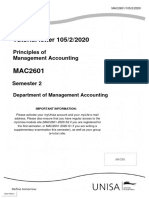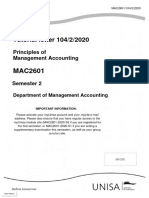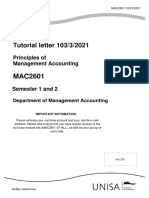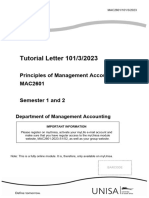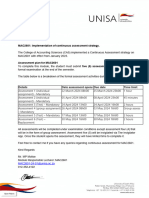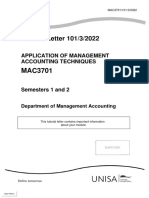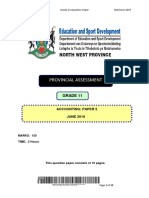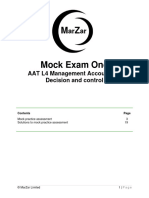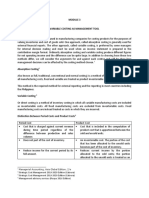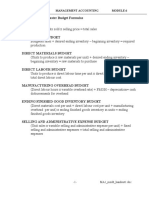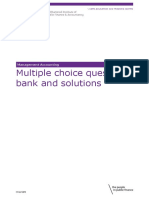MAC2601/104/1/2018
Tutorial Letter 104/1/2018
Principles of
Management Accounting
MAC2601
Semester 1
Department of Management Accounting
IMPORTANT INFORMATION:
Please activate your myUnisa account and your myLife e-mail address.
Please also ensure that you have regular access to the myUnisa module
site (MAC2601-18-S1 if you are registered for the first semester, or
MAC2601-17-S2 if you are writing a supplementary examination this
semester), as well as your group (e-tutor) site.
Note: This is an online module and therefore the study materials are available on
myUnisa. However, in order to support you in your learning process, you will also
receive some of the study materials in printed format.
Define tomorrow
� MAC2601/104/1/2018
CONTENTS
1. INTRODUCTION ...............................................................................................................3
2. PLAGIARISM ....................................................................................................................4
3. ASSIGNMENT 02/2018 (FIRST SEMESTER): WRITTEN ASSIGNMENT .......................5
4. COMMON MISTAKES TO AVOID ............................................................................... 15
5. FREQUENTLY ASKED QUESTIONS .............................................................................16
©
UNISA 2018
2
� MAC2601/104/1/2018
1. INTRODUCTION
Dear Student
This tutorial letter (104) contains assignment 2 for semester 1 of 2018. You will find important
general information about assignments 1 and 2 in your Tutorial Letter 101 and online. It is very
important that you refer to Tutorial Letter 101 for more information about Assignments 1 and 2
before you attempt these assignments.
It is also very important that you read section 2 of this tutorial letter before you start working on
your assignments. This section is about plagiarism and the plagiarism declaration that you make
by submitting any MAC2601 assignment. The assignments should be your own work and no-
one should assist you with your assignments at all. We do not allow any group work in
terms of assignments.
We also include other information in this tutorial letter that may be helpful in the process of
completing your assignments.
Kind regards,
Name Telephone Office Building E-mail
number number
N Maponya (Miss) 012 429 6345 1-54 AJH vd Walt
MAC2601-18-S1@unisa.ac.za
M Ramaleba (Mr) 012 429 4334 1-37 AJH vd Walt
J Verster (Mrs) 012 429 4767 1-33 AJH vd Walt
Any changes in lecturers' details will be communicated via myUnisa.
MAC2601 lecturers
©
UNISA 2018
3
� MAC2601/104/1/2018
2. PLAGIARISM
As mentioned in the previous section, we do not allow any group work in this module.
Students may not work together on their assignments at all and no-one may assist you
with any of your MAC2601 assignments. If the lecturers find that your assignment is
similar to the assignment of another student, you will get 0% for your assignment. It is
unacceptable that anyone, including an external institution, helps you with the
assignment.
By submitting any MAC2601 assignment, you automatically declare (see Plagiarism
Declaration below) that you have done and submitted your own work and that you are aware
of the potential consequences of plagiarism.
Plagiarism is the act of taking the words, ideas and thoughts of others and passing them off
as your own. It is a form of theft and involves a number of dishonest academic activities. All
students receive access to the Disciplinary code for students (latest version) at registration.
Please study the code. You must read Unisa's Policy on copyright infringement and
plagiarism.
Plagiarism declaration for all MAC2601 assignments
PLAGIARISM DECLARATION
I declare that this assignment is my own work.
By submitting any MAC2601 assignment, I also declare that:
I have read the Unisa Students' Disciplinary Code.
I know what plagiarism is, that plagiarism is wrong and that disciplinary steps can
be taken against me if it appears that I plagiarised.
I have not allowed any other student to copy my work and have not copied from the
work of anyone else (including, but not limited to, other students and institutions).
I have not received any assistance with the assignment.
I have not worked on the assignment in a group.
For written assignments, I have referenced all the sources that I have used.
I know that if I am deemed to be in violation of this declaration I will receive 0% for
the assignment(s) involved.
Please note: You do not have to submit the declaration. By submitting a MAC2601
assignment, you automatically declare that you adhere to all the above with regard to the
assignment.
©
UNISA 2018
4
� MAC2601/104/1/2018
3. ASSIGNMENT 02/2018 (FIRST SEMESTER): WRITTEN ASSIGNMENT
Instructions and further information:
For this assignment, you have to study Guide 1 and 2 (all twelve topics).
Marks awarded to Assignment 02/2018 weighs 75% in the calculation of your semester
mark.
The due date for this assignment is 29 March 2018 and no extension will be given
for the submission of the assignment. It is your responsibility that the University
receives your assignment before or on the due date.
The unique number for this assignment is 888535.
You are encouraged to submit your assignment online. You must keep a copy of your
assignments at all times should you be requested to resubmit the assignment.
©
UNISA 2018
5
� MAC2601/104/1/2018
ASSIGNMENT 02/2018 (FIRST SEMESTER)
QUESTION 1 – DIRECT AND ABSORPTION COSTING (35 Marks)
Hlabirwa (Pty) Ltd manufactures two types of cooking stoves (Standard and Premium) from
its factory in Polokwane. The company, founded by Tebogo Mazwi, has grown by leaps and
bounds in the past decade.
Extracts from the Absorption Costing Actual Statement of Comprehensive Income for the year
ended 31 January 2018 are set out below:
HLABIRWA (PTY) LTD
ACTUAL RESULTS FOR THE YEAR ENDED 31 JANUARY 2018
R
Sales 3 950 000
Less: Cost of sales (1 121 429)
Opening inventory 300 000
Add: Current production costs 1 020 000
Less: Closing inventory (198 571)
Gross profit 2 828 571
Less: Selling and administration costs (1 000 000)
Net profit before tax 1 918
1 828 571
Additional information:
1. Selling prices were R4 000 for Standard and R5 000 for Premium. The company's
management accountant believes the future prospects of the company are
encouraging.
2. Opening inventory as at 1 February 2017 consisted of 100 units of Standard and 150
units of Premium with a value of R120 000 and R180 000 respectively. The cost per
unit in opening inventory included a fixed manufacturing cost of R300 per cooking stove
that was applied in the 2017 financial year. The company uses the weighted average
method of inventory valuation. Opening inventory values are considered to be correct.
3. Direct materials for Standard amounted to R400 per unit and R500 per unit for Premium
for the 2018 financial year.
4. Variable manufacturing overheads for the 2018 financial year were R60 per unit.
5. The blanket fixed manufacturing overhead rate for the 2018 financial year amounted to
R300 per unit for both Standard and Premium. There were no over/under applied fixed
manufacturing overheads for the 2018 financial year.
6. During the financial year ended 31 January 2018, the company manufactured 250 units
of Standard and 500 units of Premium, selling 300 units of Standard and 550 units of
Premium.
7. It takes on average 120 minutes for a unit of Standard and 180 minutes for a unit of
Premium to be manufactured. The company paid a wage rate per hour of R200 in 2018
for the highly skilled labour used in the complex manufacturing process.
©
UNISA 2018
6
� MAC2601/104/1/2018
8. Selling and administrative costs consist of 55% fixed costs and 45% variable costs. A
1:6 ratio between Standard and Premium is applied in terms of the fixed selling and
administration costs. The variable selling and administration cost per unit sold is the
same for Standard and Premium.
REQUIRED
[Hint: Keep the direct and absorption costing notes on pages 12 – 14 of tutorial letter
103 in mind when answering this question.]
(a) Prepare the Actual Statement of Comprehensive Income for the year
ended 31 January 2018 with individual columns for Standard and Premium
using direct costing principles. A total column is not required. (22)
(b) Reconcile the given absorption costing profit with the direct costing profit
for the company as a whole. (5)
(c) Indicate why a company would prefer a direct costing system to an
absorption costing system from a management accounting perspective. (2)
(d) Assume now that the actual fixed manufacturing overheads for the 2018
financial year were R240 000 and then:
(i) Calculate the over/under recovered overhead for the 2018 (2)
financial year.
(ii) Prepare a journal entry that shows how the over/under recovered
overhead in (i) would normally be dealt with in the company's
books at the end of the period. (2)
(e) Motivate why the closing inventory amount in the given Statement of
Comprehensive Income has indeed been calculated according to an
absorption costing system. (7)
TOTAL 35
©
UNISA 2018
7
� MAC2601/104/1/2018
QUESTION 2 – STANDARD COSTING, INVENTORY VALUATION AND ROLLING
FORECASTS (45 Marks)
This question consists of three independent parts.
PART A
Musk Robotics Ltd manufactures a comprehensive range of robots to help manufacturers
improve productivity, quality and employees’ safety. The company is dedicated to increasing
the competitiveness of South African manufacturers by creating opportunities to help them
maximise their efficiency, reliability, quality, and profitability. Whether the customer is a small
or a large manufacturer, the company has a solution that will meet the customer's robot
requirements. Musk Robotics Ltd uses a standard costing system.
Musk Robotics Ltd had a major labour strike in November 2017, which affected the company's
productivity. The company agreed to increase the labour rate per hour for some categories of
workers. According to the company’s management accountant, the agreed increase in labour
rate will affect profitability. The management accountant has proposed that the company
reduce the number of hours for some categories of workers in order to manage costs. Different
workers work simultaneously on the same robot, but their individual time spent are added
together to arrive at the standard hours for the relevant robot.
One of the robot types is the A2D3, a large robot used in the construction industry.
Additional information:
The standard production cost for A2D3 is:
R
Cost of direct material: plastic (360 kg @ R95 per kg) 34 200
Cost of direct material: wood (950 kg @ R145 per kg 137 750
Direct labour (910 hours @ R145 per hour) 130 500
Variable manufacturing overheads varying with hours worked 59 150
(910 hours at R65 per hour)
Applied fixed manufacturing overheads -
Standard production cost per A2D3 361 600
The budgeted selling price of an A2D3 robot (one "unit") is R440 000 and a variable
selling cost of R23 500 per unit applies.
The following are the actual results for the year ended 31 January 2018 in terms of
A2D3 robots, in which 25 A2D3 robots were manufactured and sold:
R
Total cost of direct material: plastic (i)?
(350 kg/robot @ R100 per kg for 25 robots)
Total cost of direct material: wood 3 750 000
(1 000 kg/robot @ R(ii)? per kg for 25 robots)
Total direct labour ((iii)? hours/robot @ R150 per hour for 25 robots) 3 562 500
Total variable manufacturing overheads for 25 robots 1 200 000
Total variable selling costs for 25 robots 575 000
Sales revenue 11 250 000
©
UNISA 2018
8
� MAC2601/104/1/2018
PART B
Good Service (Pty) Ltd services motor vehicles. The company buys spare parts for use as
required in their services. During the month ended 31 December 2017, the following spare
parts were bought and/or issued to the service delivery department:
Purchase date Serial number Cost price Date issued to
service
delivery
department
9 December JP309 R550 -
12 December KP208 R1 000 -
21 December LS909 R900 27 December
There were no spare parts in store as at 1 December 2017. A stock count was held on 31
December 2017 and it was determined that the spare parts with the serial numbers JP309 and
KP208 were still in store.
PART C
Pretoriuskop (Pty) Ltd organises small events according to client specifications and uses a job
costing system. On average, the event coordinators start arranging the event about two
months before the final event date. This subsidiary of the Parktheme group is new and the
holding company therefore requested internal reporting to be done on a monthly basis for the
first few years of operation in order for profitability and seasonal trends to be monitored.
January 2018 was the second month of operations for the company. At 31 January 2018 you
had the following information available:
Information regarding events of which the coordination started during December 2017:
Event Final event date Materials issued to event Labour cost incurred on
event
During During During During
December January December January
2017 2018 2017 2018
Kruger 27 January 2018 R800 R2 200 R400 R1 200
Birthday
Party
Mdhluli 18 February R1 200 R1 000 R1 200 R300
Stork Tea 2018
©
UNISA 2018
9
� MAC2601/104/1/2018
On 13 January 2018, the company started arranging the Rakhomo Graduation Party to
be held on 25 April 2018. The following costs relate to this event for January 2018:
Materials issued to the event during January 2018 R900
Labour cost incurred on the event during January 2018 R800
Manufacturing overheads applied to the event for January 2018 ?
Manufacturing overhead costs are allocated based on the cost of materials issued. The
budgeted manufacturing overhead costs for the company for the financial year ended
31 December 2018 is R53 760 and the budgeted cost of materials issued by the
company for the financial year ended 31 December 2018 is R48 000.
The R10 000 total revenue for the Kruger party is receivable in February 2018.
There were no variable manufacturing overheads incurred up to 31 January 2018.
REQUIRED
In respect of Part A
(a) Calculate the missing figures for (i) to (iii) in the actual results for the
year ended 31 January 2018 presented above. (6)
(b) Calculate the following variances: (13)
(i) Total variance for direct materials: plastic
(ii) Material purchase price variance: wood
(iii) Labour rate variance
(iv) Labour efficiency variance
(v) Variable manufacturing overhead expenditure variance for
overheads that vary with hours worked (round overhead
rates to the nearest rand)
(vi) Variable manufacturing overhead efficiency variance for
overheads that vary with hours worked (round overhead
rates to the nearest rand)
(vii) Selling price variance.
(c) Write a report to management, discussing the differences between a
budget and a standard. (4)
(d) List two possible causes for each of the following variances that you
have calculated in (b):
(i) Material purchase price variance: wood (2)
(ii) Labour rate variance (2)
(iii) Variable manufacturing overhead efficiency variance for (2)
overheads that vary with hours worked.
(e) List two differences between fixed and flexible budgets. (2)
©
UNISA 2018
10
� MAC2601/104/1/2018
In respect of Part B
(f) Calculate the respective material control account balances as at
31 December 2017 according to the first-in-first-out (FIFO) method, the
weighted average method and the specific identification method of
inventory valuation. Also discuss why there are differences between
these balances or why there are no differences between these
balances, as applicable. (9)
(g) Calculate the respective material control account balances as at
31 December 2017 according to the first-in-first-out (FIFO) method, the
weighted average method and the specific identification method of
inventory valuation. Also discuss why there are differences between
these balances or why there are no differences between these
balances, as applicable. (5)
In respect of Part C
(h) Calculate the total gross profit that the company will make on the
Kruger Birthday Party. (5)
(i) Calculate the value of work-in-progress as at 31 January 2018. (5)
Total 55
QUESTION 3 – PROCESS COSTING AND ACTIVITY BASED COSTING (30 Marks)
Phophi Ramaphosa owns and operates a company that produces wood desks used in
classrooms throughout the world. The name of the company is Desk Products (Pty) Ltd.
PART A
Desk Products (Pty) Ltd maintains an advantage over its competitors by producing one desk
in large quantities – 4 000 to 8 000 desks per month – using a universally accepted design.
This enables the company to buy materials in bulk, often leading to volume price discounts
from suppliers. Because large volumes of the exact same desk is produced, Desk Products
chose to apply a process costing system. The company purchases pre-cut wood materials
from suppliers and the production department then requisitions pre-cut materials and
hardware from the raw materials storeroom. The desks are then produced in a single process
that consists of assembly and finishing (sanding, painting and moving completed desks to the
finished goods warehouse).
Materials are added at the beginning of the process and conversion takes place evenly
throughout the process.
©
UNISA 2018
11
� MAC2601/104/1/2018
Cost and production figures for February 2018 are as follows:
Units
WIP (1 February 2018) - 30% complete 2 200
New units put into production
in the current month 25 300
Units completed in the current month 17 600
WIP (28 February 2018) - 60% complete 4 400
Normal loss 15% of units that reach the wastage point
Wastage point 70%
WIP: 1 February 2018
Material R792 000
Conversion cost R113 100
Material added during February 2018 R9 800 000
Labour for February 2018 R2 820 000
Overheads for February 2018 R1 516 380
PART B
A new competitor recently began producing a similar desk, and Phophi is concerned about
whether Desk Products' production costs are reasonable. The high level of competition has
led to Phophi introducing the deluxe Professional Desk and high-end Executive Desk for
customers who have been requesting such products for a long time now.
The company is considering the use of activity-based costing (ABC) for the Executive and
Professional desks.
The following budgeted information pertains to the month of April 2018:
Units manufactured
Professional desk 7 000
Executive desk 3 000
Direct Material per unit
Professional desk R800
Executive desk R950
Direct Labour @ R40 per hour ?
Professional desk 2 hours per desk
Executive desk 3 hours per desk
Manufacturing overhead costs R522 000
©
UNISA 2018
12
� MAC2601/104/1/2018
The following activities, cost pools, cost drivers and requirements of the individual products
have been identified:
Cost Professional Executive
Activity pool Cost driver desk desk
Machine set
up 208 800 Number of set ups 4 set ups 6 set ups
Material
handling 130 500 Material movements 50 movements 70 movements
Maintenance 104 400 Maintenance hours 110 hours 90 hours
Quality Number of quality
control 78 300 inspections 20 inspections 25 inspections
522 000
REQUIRED
In respect of part A
(a) Prepare the February 2018 Quantity Statement according to the
weighted average method. Round units to the nearest integer. (5)
(b) Prepare the February 2018 Production Cost Statement according
to weighted average method. (2)
(c) Prepare the February 2018 Allocation Statement according to (8)
weighted average method.
In respect of part B
(d) Calculate the product cost per unit for both desks under traditional
costing, using direct labour hours as a basis. (4)
(e) Calculate the product cost per unit for both desks under activity-
based costing. (8)
(f) List three advantages of activity-based costing. (3)
Total 30
QUESTION 4 – RELEVANT COSTING (30 marks)
Green Soft Toys (Pty) Ltd manufactures stuffed animals for children, namely Crocodile,
Sheep, Gorilla and Hippo. All the stuffed animals are green in colour to promote nature
conservation. All the stuffed animals, except for the hippo, are hand-made.
The company has provided you with the following budgeted information regarding variable
costs for the year ended 30 June 2018:
©
UNISA 2018
13
� MAC2601/104/1/2018
Crocodile Sheep Gorilla Hippo
Fabric per unit 0,5 0,3 0,8 2,0
(metres)
Price of fabric per R28 R28 R28 R28
metre
Direct labour hours 3 3,5 2,6 -
per unit
Machine hours per - - - 1,2
unit
Cost per direct R25 R25 R25 n.a.
labour hour
Cost per machine n.a. n.a. n.a. R16
hour
Variable selling R4,00 R2,00 R5,00 R6,00
cost per unit
Other variable R35,00 R70,10 R30,60 R50
manufacturing
overhead cost per
unit
Additional information:
Total budgeted fixed manufacturing overheads for the year ended 30 June 2018
amounts to R800 000. Fixed manufacturing overheads are allocated on the basis of
production.
It is budgeted that no opening or closing inventory of finished goods will exist on
1 July 2017 or 30 June 2018.
It is budgeted that fabric of 200 metres will be in store on 1 July 2017. These materials
were bought at R28. A maximum of 3 800 additional metres of fabric can be bought
from the supplier at the same price per metre. No other suppliers stock the fabric used
by the company.
9 000 labour hours and 1 000 machine hours are available to the company
for the specific financial year.
Each soft toy is sold for R200.
The selling costs per unit are for delivery and differ for the different stuffed animals due
to their size and shape differences.
The estimated demand for the products from regular customers for the year ended
30 June 2018 is as follows:
Crocodile Sheep Gorilla Hippo
Units 1 440 1 800 1 300 800
©
UNISA 2018
14
� MAC2601/104/1/2018
REQUIRED
(a) Calculate the optimal production mix for Green Soft Toys (Pty) Ltd for (13)
the year ended 30 June 2018.
(b) Assume now that Green Soft Toys (Pty) Ltd has the option to employ (10)
additional casual labourers who can supply up to 2 000 hours of
additional labour at R30 per hour. Discuss whether it is worthwhile from
a quantitative perspective to employ additional labour and, if so, for how
many hours.
(c) Assume a once-off client offered Green Soft Toys (Pty) Ltd an amount (7)
of R75 000 for a special order of 500 hippos and that the machinery of
Green Soft Toys (Pty) Ltd can only handle the manufacturing of up to
1000 Hippos in total per year. Discuss whether Green Soft Toys (Pty)
Ltd should accept the offer from a quantitative perspective
Total 30
4. COMMON MISTAKES TO AVOID
The following are a few examples of mistakes that students often make in MAC2601. The
first section relates to the submission of assignments and the second to MAC2601 contents.
Please try to avoid these mistakes, as they could cost you marks:
Assignment submission
1. Submitting assignment 02 online as an MS Excel or MS Word file instead of in PDF format.
2. Submitting the wrong module's assignment or an unrelated document as if it is the
MAC2601 assignment.
3. Read-protecting the assignment 02.
4. Not showing and referencing all your calculations in assignment 02.
5. Not reading the "required" carefully.
6. Looking for a question of the same format to use as a "recipe" for answering the assignment
question instead of referring back to basic principles to answer the question.
7. Allowing someone to assist you with any MAC2601 assignments that need to be your own
work!
©
UNISA 2018
15
� MAC2601/104/1/2018
Content: General
1. Omitting opening and closing inventory in a direct and absorption costing question even if
these exist.
2. Using the FIFO method when a question requires the weighted average method to be used,
and vice versa (various topics).
3. Using the direct costing method when use of the absorption costing method is required, and
vice versa.
4. Omitting the formulae used in a CVP question.
5. Omitting the actual production in standard costing variance calculations.
6. Treating variable selling costs as part of variable production costs.
7. Calculating variable selling costs based on production units instead of sales units.
8. Preparing incomplete general ledger accounts for a job costing system and/or omitting
applied overheads.
9. Calculating only the difference between direct and absorption costing profits and presenting
this as a "reconciliation" (the difference needs to be explained by further calculations e.g. like
in study guide 1, activity 10.2).
10. Not knowing how to calculate the normal loss in a process costing system.
11. Doing only calculations when asked to draw a decision tree.
5. FREQUENTLY ASKED QUESTIONS
The following are examples of questions that the lecturers frequently get with regard to
assignments:
Q: Can I submit my assignment through the post?
A: Yes, we do allow it, although submitting your assignment online may provide an easier trail
to follow should there be any doubt about whether the University received it or not. However,
if you submit by post, please ensure that you keep a copy of your assignment in case we never
received it and require a re-submission.
Q: Why have I not received my assignment 02 marks yet?
A: Assignment 01 is a multiple-choice (MCQ) assignment. It is marked automatically by the
computer system. However, assignment 02 takes longer to process and mark as it is a written
assignment that is marked by a (human) internal or external marker. Marks are captured as
©
UNISA 2018
16
� MAC2601/104/1/2018
individual assignments are marked and therefore not released all at once for all the students
registered for the module as with a MCQ assignment. It can take more than a month after the
due date for your marks for assignment 02 to become available. If you, however, suspect that
your assignment was not received by the University, etc., please contact Student Assessment
Administration urgently and before the exam date.
Q: What do I do if I do not agree with my assignment 02 mark?
A: Please e-mail a copy of your marked and returned assignment to MAC2601-18-
S1@unisa.ac.za before the exam date, clearly indicating with what and why you do not agree.
The lecturers will investigate whether your marks need to be adjusted or not. No assignment
marks will be adjusted after the exam date, so make sure that you follow up with us in time.
© UNISA 2018. All rights reserved. No part of this document may be reproduced or transmitted in any form or by any means without
prior written permission of Unisa.
©
UNISA 2018
17

